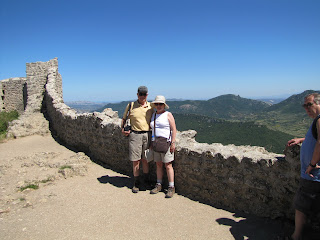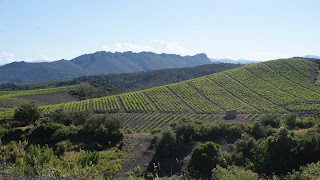WARNING: OVERABUNDANCE of PHOTOS today. We couldn't help ourselves. Also, Clark asked me to remind me to tell you that you can enlarge these photos by clicking on them and you can zoom in on parts as well.
We're off relatively on time, but waste a half hour because we need gas and hadn't purchased it in Thézan before leaving. But with a bit of help from Olga, we find some not too far off our route. We manage to arrive at Salses by 10:30 which should give us enough time to see it before it closes at 12:15 for lunch.
Canigou is spectacularly present along the A9 drive toward Salses and we will see it frequently on our travels today.
 Canigou (nearest snow-covered Pyrenee) taken from Salses
Canigou (nearest snow-covered Pyrenee) taken from SalsesSalses is a mostly 15th century intact Spanish fort, built near Perpignan when that area was the border between France and Catalonia (now part of Spain). It was built for "modern" warfare, when gunpowder, cannons and metal cannon balls were new technologies. Hence the castle is built low, half of it below ground level, with extra thick walls to minimize the damage that could be inflicted to defensive walls from the cannon balls that had the power to break down stone walls. Because of its strategic position, its size is deceptive and it appears from a distance to be ruined since not much is visible above ground.




The castle has triple walled defenses with a moat that could be flooded when needed between the first two curtain walls. Inside the fort, there is yet another set of walls and a "donjon" (keep) that separates and protects the governor's and officers' part of the fort, since that is the nerve center of the fort. It also protects the essential storage and food services parts of the fort.
 Salses with Canigou in background
Salses with Canigou in background Donjon (center building, 7 floors high)
Donjon (center building, 7 floors high)We are rushed to join a tour that has just begun and so have no time to orient ourselves. We've been provided English information about the fort, but don't have time to read it before beginning the tour, which unfortunately, but expectedly, is in French. The guide however is made aware that we have non-French speakers and asks me if I'll be able to translate for Dave, Janis, and Clark. She speaks clearly and I'm able to understand most of what she tells us. I can pass brief descriptions on to the rest, although Janis is also understanding the gist of the tour from her rather rusty, but still usable French.


We learn about the 800 murder holes (holes in the walls for shooting arrows or cannon balls at people. 400 of these look out from the fort, the other 400 are on the interior aimed at strategic places where the defenses could be breached. The donjon is particularly riddled with these murder holes.

Thanks to 3 streams that flow under the castle, the castle has plenty of water and good water storage. It is very near the Mediterranean on the inland side of the large Étang de Salses (the salt water marsh behind the main Mediterranean sand bars).

They even have a system of heating water that is stored in a cistern abutting a large cooking fireplace in the boulangerie (bakery). This hot water provides water for the adjoining "vannes" which is a bathroom (without toilet) where the governor and officers can have a sauna type steam bath, a bath in stone carved tubs, or a wash up in the sink. All with warm water. Very clever, but for one detail. The stone tubs were also used for washing and/or butchering livestock.
We see the stable where 20 head of cows were kept for milking. The dairy is next to the stables and has a natural refrigerator (a chimney that constantly brings in cool air) where the milk, cheeses, and butter which are all made on the premises are stored.
At the end of the tour, we explore the outer courtyard where the 1500 soldiers lived and worked. We see stables for the horses, a chapel, and an outer tower that shows us how the gases and heat of the cannons were dissipated by means of a central shaft with a well of cool water at the bottom.

We decide to drive toward Peyrepetuse and look for a place to have lunch along the way. The views of Canigou and the Pyrenees are wonderful today (wish you were here, Judy) and we stop a few times for photos.

We find an "aire" (picnic spot) with a cement table and benches in the shade. Lunch is a sandwich concocted by Janis to use up our leftover lamb and ratatouille. It's really tasty in our French baguette today. We're also getting smarter, freezing half filled water bottles the night before so that we have ice water for our lunch. And we pack the water and a couple of beers in the cooler bag we got at Roquefort yesterday, so even the beer is cold for lunch.
With a gentle breeze blowing to keep us cool and beautiful views of vinyards, hills and the jagged peaks of the Pyrenean foothills, it's hard to leave, but we have places to go this afternoon, so we head into the Gorges of Galamus to make our way to Peyrepetuse.

Some of you (Duane and Judy in particular) have probably heard Dave swear he'd never take that road again. However, he couldn't resist and we have another "hold your breath" ascent through a low spot in the rocky cliffs above the valley. The views are incredible and we stop at a large parking area that provides views into the valley and deep into the gorge and its waterfall below us. There is a hermitage built into the cliff wall that can be accessed from this parking area. (In fact there are many hiking trails that can be accessed from here.)

We marvel that the place has a bus stop from the town in the valley below. We KNOW that the road is not wide enough for a bus, at least not for a bus and car to pass each other and this is a two-way road. What could they be thinking?

We continue on our way and the road becomes absolutely treacherous. It is carved out of the rock and snakes its way vertiginously along the drop off. The stone wall on the left in the photo below is supposed to keep you from going over the cliff into the abyss. I have my doubts.

Needless to say, it is narrower than before the rest stop because now we are literally climbing across the rocks at the top. We meet a couple of cars and try to pass at "wider" spaces in the road. One time, there's only about an inch between our car mirror and the rock that has been carved away to make the road. On the other side of the car, there's only an inch between our mirror and the other car. We inch (literally) our way past each other and continue. Once over the top, the road widens a bit (still no shoulders) and we make our way down and around. We're only 19 km from Peyrepetuse, but it takes a long time to wind our way along these twisty roads. We can see Peyreptuse above us, but must travel another 7 km to get to where you can access it.
At the turn off for Peyrepetuse, I spot a sign indicating a dolmen. We follow a little two track gravel path for a fair distance without seeing any signs of a dolmen. The two tracks fade significantly and we turn around at a house (how'd that get here?) and give up our quest.
We ascend the switchbacks up to the parking lot of the castle and I'm guessing that Janis and Clark are thankful for each bit of height we gain. The castle looks impregnable on its rock outcropping and I don't see how you even climb the "15 minute walk" to get to the top.
Peyrepetuse is a hilltop (mountaintop?) fortified castle that is part of the defensive system that once protected the border between France and Spain. It is considered a Cathare castle, but we're not sure why. But it is an impressive ruin.










 St Louis Stairs - original to 13th century, slippery as can be, sloping downhill and treacherous. Janis does a butt plant on one of the worst, but, glad to say, manages to avoid any damage.
St Louis Stairs - original to 13th century, slippery as can be, sloping downhill and treacherous. Janis does a butt plant on one of the worst, but, glad to say, manages to avoid any damage.
As I write this, I am sitting on the terrace overlooking the valley while Dave, Janis and Clark are exploring the castle. There's not a cloud in the sky and the late afternoon sun (it's 4 PM right now) shines on castle, valley and the Pyrenees in the distance. A great view for doing work.

I expect that Dave is re-taking all the photos he took the first two times he was here.
The intrepid explorers have just appeared so it's time we head home. Will finish this later.
Much later: My plan was to finish this blog after dinner, but it is the next morning and I'm finally back on task. It's hard to stay up long after aperos and dinner.
We drove home via views of Queribus castle, but not visiting the town which requires parking at the bottom of the hill and walking up.

We stop a couple times for pictures. Every corner brings with it a new vista that just begs to be photographed. We can't resist stopping along the way.



We stop at the Aire de Salses on the A9, hoping for the overview of Salses fortress. But no luck.
Dinner tonight is extended appetizers, but even that takes us from 7:30 till 10:30 to finish. It is a fabulous evening to be out on the terrasse reminiscing about the sights we saw today. The day was as perfect as you could ask for, a great way to close out Janis and Clark's visit. Janis always asks "How will you top that tomorrow?" and each day has been as good or better than the last. But I'm glad tomorrow's a rest day because I think we've run out of days to top this one!
No comments:
Post a Comment